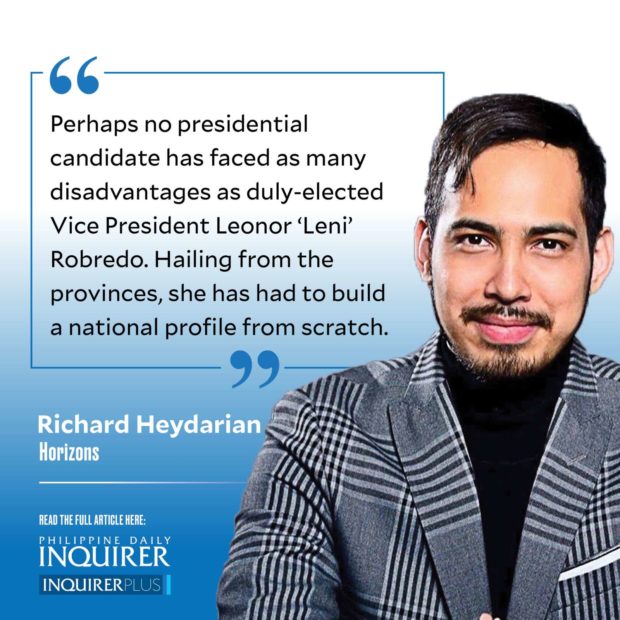Leni presidency: Three possible scenarios
“The darker the night, the brighter the stars.” This was the powerful verse that Russian writer Vasily Rozanov recited in his critical review of Fyodor Dostoevsky’s works, most notably “Crime and Punishment” (1866).
Perhaps no presidential candidate has faced as many disadvantages as duly-elected Vice President Leonor “Leni” Robredo. Hailing from the provinces, she has had to build a national profile from scratch. Thanks to the world-renowned good governance record of the late Jesse Robredo, she has been bereft of any political dynasty to lean on for machinery, votes, and protection. Not to mention, stubborn patriarchal biases against female leaders.
Without a doubt, however, what has made her political career in recent years such a tortuous journey is the systematic and sustained hostility of the formidable Duterte-Marcos axis. Over the past six years, Leni has been at the receiving end of an unprecedented campaign of disinformation and denigration, which largely explains her relatively low net trust ratings throughout the years.
On the one hand, the Marcoses never forgave her for the upset victory in the 2016 elections. Meanwhile, President Duterte couldn’t tolerate her disagreements over the incumbent’s mindless, ill-conceived, and ultimately disastrous “war on drugs,” which claimed the lives of thousands of indigent Filipinos without netting a single real “big fish.”
Hence, Leni found herself squeezed between two pillars of illiberal-authoritarian politics in contemporary Philippine history. Accordingly, a duly-elected vice president, the second highest-ranking official in our democracy, had to face the wrath of both the so-called “Solid North” and “Solid South.” Thanks to well-oiled networks of disinformation, countless folks have been deceived into believing the most outrageous and salacious calumnies against the Vice President.
What’s astonishing, however, is that Leni may yet pull off an electoral surprise in an even more high-stakes showdown with the scion of a former dictator. As we enter the final stretch of the elections, her army of passionate and devoted volunteers has been mobilizing nationwide support and “grand rallies” from the northernmost provinces of the country to the heartland of Mindanao, including Davao.
But should she turn the tide, the question is: What would a Leni presidency look like? In brief, this would depend on four major factors, namely (i) the margin and circumstances of her election victory; (ii) coherence of her support base and astuteness of her strategists; (iii) the strength and mobilization power of her rivals as well as traditional politicians dominating other branches of the state; and (iv) support/pressure from external powers and the broader international community.
Dear reader, given the limited space in a single column, let me provide a preliminary analysis of the three more likely scenarios to consider. First is the “minimalist” scenario, whereby Leni pulls off a huge upset, yet the margins remain razor-thin and, similar to 2016, the losing party systematically and effectively questions the mandate of the victor.
Facing an unfriendly legislature packed with illiberal figures and traditional politicians, and a deeply polarized society, Leni might struggle to press ahead with good governance initiatives. She might even face impeachment trials by partisans of the ancien régime or, as in our two former female presidents, even coup attempts by reactionary elements.
Under the second scenario, Leni wins with statistically significant margins, thanks to en masse defection within the ranks and soft-support base of the current frontrunner, especially in “swing provinces” in Mindanao and other vote-rich areas of the country.
Nevertheless, in the interest of establishing a semblance of unity after a polarizing election, the new administration would engage in what political scientists call “pacted transition,” namely a negotiated settlement with remnants of the former administration in order to build a sustainable political coalition to run the country. Hence, progressive reforms are balanced against realpolitik.
The final scenario is a “maximalist” Leni presidency, whereby not only is her margin of victory significant, but also the outpouring of support from a determined and coherent social movement as well as from international partners, including flagship democracies.
Thus, despite facing hostility from traditional politicians and an embittered ancien régime, the Leni administration could press ahead with contentious yet transformational reforms in order to make the Philippines a true democracy after a century of swinging between autocrats and liberal oligarchs. In short, the struggle for a progressive Philippines doesn’t end at the ballot box.





















